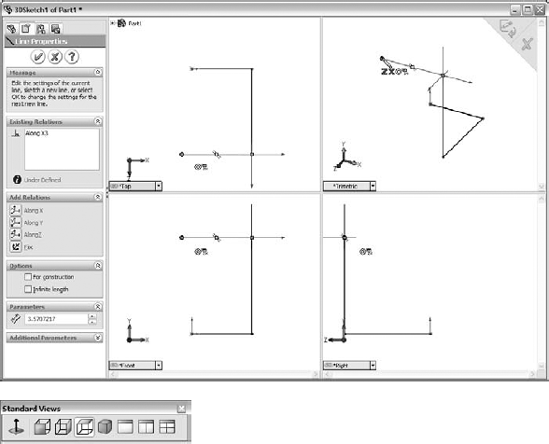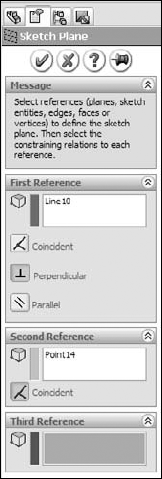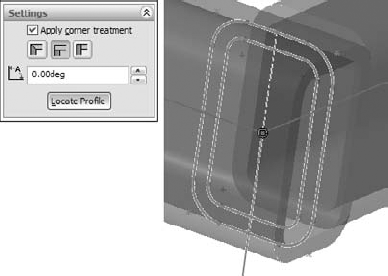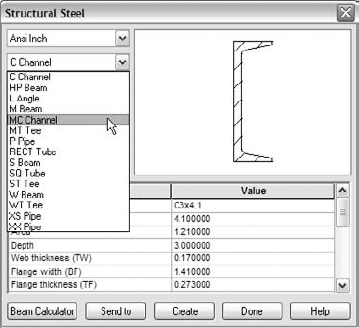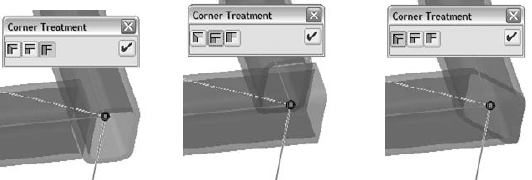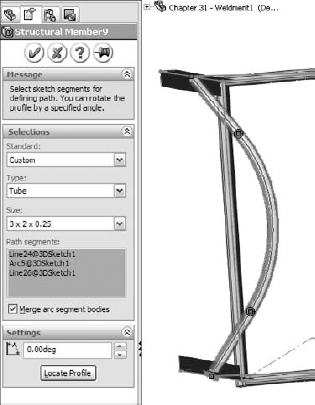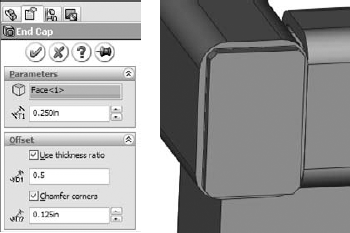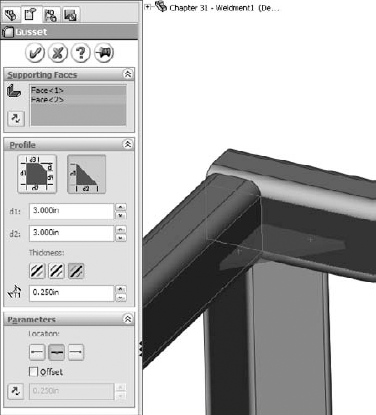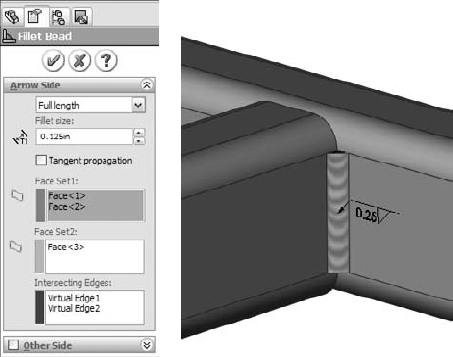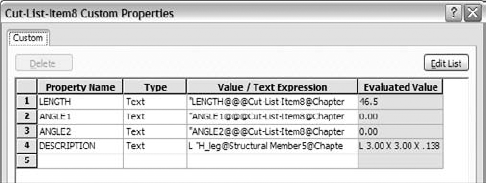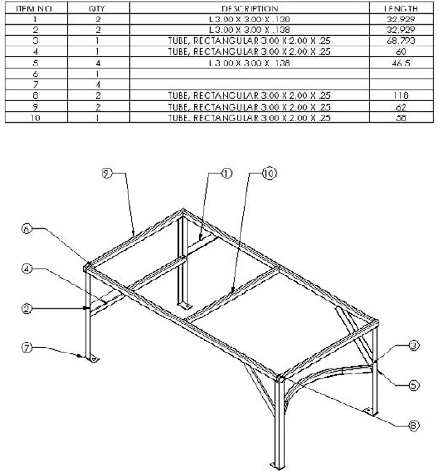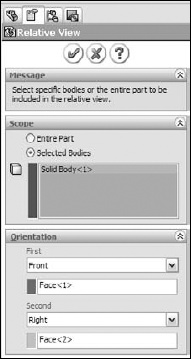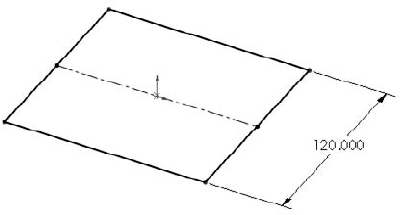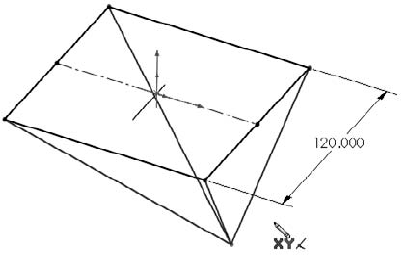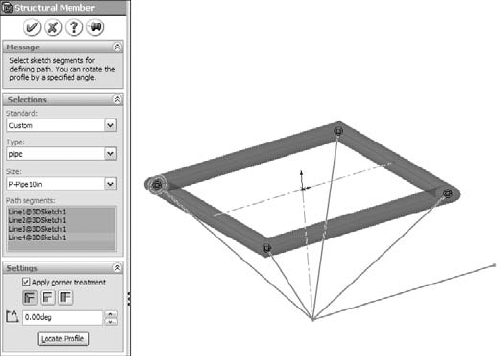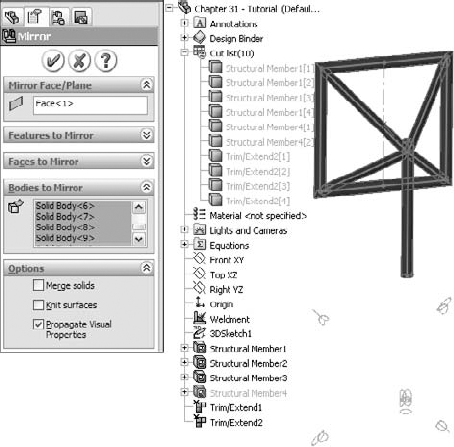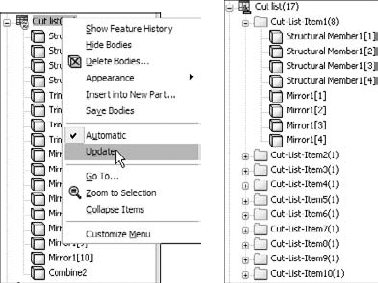IN THIS CHAPTER
Sketching in 3D
Using Weldment tools
Using non-structural components
Using sub-weldments
Using Cut lists
Creating Weldment drawings
Tutorial: Working with weldments
Weldments in SolidWorks are built on driving structural profiles along sketch entities in a multibody part environment. Weldment members can be curved, you can make them using standard or custom profiles, and you can build them from both 2D and 3D sketches. A Cut list within the part keeps track of how much of each profile is needed to fabricate the weldment. Weldments are specialized parts that are similar in some ways to sheet metal parts.
You can use weldments for round or rectangular tubular structures, structures made from channels, flanged sections, standard or custom shapes, gussets, and end caps, and they can also represent weld beads in the part. You can also use weldments to create structures that are bolted together, structural aluminum extrusion frames, and vinyl window frames, and you can put them into assemblies with other parts such as castings, sheet metal, and fabricated plate.
Earlier chapters discuss the tools that are available for 3D sketches; this chapter covers techniques for 3D sketching.
When working in a 3D sketch, the cursor and Origin initially look as shown in Figure 31.1. The large red Origin is called the space handle, with the red legs indicating the active sketching plane. Any sketch entities that you draw lie on this plane. The cursor also indicates the plane to which the active sketching plane is parallel. The XY graphic shown in Figure 31.1 does not mean that the sketch is going to be on the XY plane, just parallel to it.
Pressing the Tab key causes the active sketching plane to toggle between XY, YZ, and ZX. The active sketching plane indication does not create any sketch relations; it just lets you know the orientation of the sketch entities that are being placed. If you want to create a skew line that is not parallel to any standard plane, you can do this by sketching to available endpoints, vertices, Origins, and so on. If there are not any entities to snap to, then you need to accept the planar placement, turn off the sketch tool, rotate the view, and move one end of the sketch entity.
An excellent tool to help you visualize what is happening in a 3D sketch is the Four Viewport view. This divides the screen into four quadrants, displaying the Front, Top, and Right views in addition to the trimetric or isometric view. You can sketch in any of the viewports, and the sketch updates live in all of the viewports simultaneously. This arrangement is shown in Figure 31.2. You can easily access the divided viewport screen by using buttons on the Standard Views toolbar or the view selector in the lower-left corner of the graphics window. You can also manually split the screen by using the splitter bars at the lower-left and upper-right ends of the scroll bar areas around the graphics window. These window elements are also described in Chapter 2.
When unconstrained entities in a 3D sketch are moved, they move in the plane of the screen. This can lead to unexpected results when viewing something at an angle, moving it, and then rotating the view, which shows that it has shot off into deep interplanetary space. This is another reason for using the Four Viewport view, which enables you to see what is going on from all points of view at once.
On the other hand, several other relations are available in 3D sketches that are not found in 2D sketches, such as AlongX, AlongY, AlongZ, and OnSurface.
As mentioned earlier, relations in 3D sketches are not projected like they are in 2D sketches. For example, an entity in a 2D sketch can be made coincident to an entity that is out of plane. This is because to make the relation, the out-of-plane entity is projected into the sketch plane, and the relation is made to the projection. In a 3D sketch, Coincident means Coincident, with no projection.
As a general caution, keep in mind that solving sketches in 3D is more difficult than it is in 2D. You will see more situations where sketch relations fail, or flip in the wrong direction. Angle dimensions in particular are notorious in 3D sketches for flipping direction if they change and go across the 180-degree mark. When possible, it is advisable to work with fully defined sketches, and also to be careful (and conservative) with sketch relations.
For example, the sketch shown in Figure 31.3 cannot be fully defined without also overdefining the sketch. The main difficulty is that the combination of the tangent arc and the symmetric legs of the end brace cannot be located rotationally, even using the questionable reliability of 3D planes that are discussed next. The only workable answer to this is to create a separate 2D sketch on a real 2D sketch plane, where the plane is defined by the elements of the 3D sketch. If you are interested in examining this part in detail, then you can find it on the CD-ROM. The filename is Chapter 31 – Cant Define.SLDPRT.
Unfortunately, there is a lot to watch out for with 3D planes, as they are called. The first thing to watch out for is that they do not follow their original definition like normal Reference Geometry type planes. Figure 31.4 shows the PropertyManager interface for creating 3D planes; however, keep in mind that the plane does not maintain the original relation to these initial references. The parent-and-child relations that SolidWorks users are used to are suspended for this one function, or work in the reverse from what you normally expect.
Three-dimensional planes cannot be fully defined unless there is some sketch geometry on the plane that is in turn related to something else. Relations cannot be applied directly to the plane itself, only to other entities on the plane. Horizontal and Vertical relations of entities on the plane are relative only to the plane and not to the rest of the part, and so making a line horizontal on the plane does not mean anything when the plane rotates (which it is free to do until it is somehow constrained to prevent this).
Beyond this, when a plane violates a sketch relation, the relation is not reported, which severely limits the amount of confidence that you can place in planes that are created in this way.
The basic recommendation on this tool is to either use it at your own risk, having been warned, or simply to leave it alone. The preference is to use reference planes that are created in the familiar and reliable way. Although this requires that the planes be made beforehand, it guarantees that the planes will stay where you put them, or move in controllable ways.
If you choose to use these planes, to activate the plane for sketching, then you can double-click the plane with the cursor, or select the plane and press the 3D Sketch On Plane button on the Sketch toolbar. The plane is activated when it displays a grid. You can double-click an empty space to return to regular 3D Sketch mode.
Some path segments that are allowed in 3D sketches can only be used if they are sketched on a plane. These entities include circles and arcs, and can include splines, although splines are not required to be on a plane. It has already been mentioned that to sketch on a 3D Plane (a plane created within the 3D sketch), you can simply double-click the plane.
To sketch on a standard plane or reference geometry plane, you can Ctrl-click the border of the plane with the sketch entity icon active or double-click on the plane. The space handle moves, indicating that newly created sketch entities will lie in the selected plane.
Note
When sketching a rectangle, you are accustomed to getting horizontal and vertical relations on the lines of the rectangle, which orient it in space. When sketched on a selected plane in a 3D sketch, the elements of a rectangle are given relations similar to those of a parallelogram, where parallel and perpendicular relations are used instead of horizontal and vertical ones.
This is due in part to the nature of the 3D sketch, where horizontal and vertical relations are replaced by AlongX, AlongY, and AlongZ.
This feature does not offer any special default settings, except for the ability to set custom properties that transfer to all Cut list items that are created in the current part, and the fact that the Merge Result option is turned off by default in Weldment parts. The former is important when multiple weldments go together to make an assembly. You can access the custom properties interface, shown in Figure 31.5, through the Properties option on the Weldment feature RMB menu.
Note
A single Structural Member feature may create multiple bodies, with each body corresponding to a single cut length of stock. In other words, the feature name "Structural Member" does not necessarily refer to a single piece of the weldment, although it may.
One limitation of the use of sketches in Structural Member features is that only two selected sketch entities may intersect at any one location. For example, at each corner of a cube, three path segments intersect, and so you can only select two of those elements at one time to create a Structural Member feature. Because each of the path segments requires a piece of metal, the leftover path segments may be used by a second Structural Member feature.
When creating the sketch for the weldment, it is important to decide what the sketch represents. For example, does it represent the centerline of the structural elements, or does it represent the closest that the elements can be to one another or to something else? You can orient and position structural shape profiles relative to the frame sketch in several ways, with positioning at the shape centroid being probably the most intuitive for closed shapes, and a corner being most intuitive for angle channels.
Figure 31.6 shows a single 3D sketch of a simple frame and a Structural Member feature in the process of creation. You must select the standard first, then the type, and finally the size. A limited number of profiles come with the software, and although it is very likely that you will need to create some custom profiles; fortunately, they are very easy to create.
To access a large number of weldment profiles in various standards, open the Design Library and select the SolidWorks Content icon. Under that, the Weldments folder has several zip files containing weldment profiles. Ctrl-click an icon to down load the file, and then extract the contents of the zip file to the library location you have established for your weldment profiles.
When you apply a profile to a path segment in a Structural Member feature, the profile must have some relationship to the path segment. The default point where the path "pierces" the profile is at the sketch Origin. To change the pierce point, you can click the Locate Profile button at the bottom of the Structural Member PropertyManager, which zooms the view to present the profile sketch so that you can select another sketch point to use as the pierce point. You can select any sketch point on the profile, including endpoints, sketch points, and virtual sharp points if they are present in the sketch.
Profile sketches are generally surrounded by several sketch points, which may seem unnecessary until you consider that you can use any of the points to position the profile. The Settings panel at the bottom of the Structural Member PropertyManager is shown in Figure 31.7, and displays a profile sketch with the interface.
In addition to locating the profile sketch, you can also rotate the profile using the Angle field in the Settings panel. This rotates all of the bodies that are created by the Structural Member feature at the same time. In the example of the four-legged frame, if the legs are rectangular or circular, they can all be created in the same Structural Member feature because they are all rotated in the same way. However, if the legs were made from an asymmetrical shape such as an angle, then each leg would need to be made using a separate Structural Member feature, with each leg rotated differently.
You can select disjoint sketch segments in a single Structural Member feature if they are parallel to the first segment and use the same location and orientation. For example, in Figure 31.6, notice the four angled supports in the corners attaching to the legs. Because they are parallel in pairs, all four of these supports could not be made in a single Structural Member feature; however, they could be made in two features or by one feature and a mirror. Later in this section, when those path segments are actually used to place Structural Members, the additional requirement of using an angle profile means that the profiles each need to be rotated differently from one another, and thus cannot be used in a single Structural Member feature. Ultimately, the way to accomplish this is by using one Structural Member feature and two Mirror features, thus mirroring the body that is created.
Most of the custom profiles that you will need may be simply new sizes of existing profiles. You can easily create a custom profile by opening an existing profile, editing it, and saving it under a different name using the Save As command. It is important to note that when creating a weldment profile, a sketch must be selected prior to initiating the Save As command. Weldment profiles are Library Features, and use a *.sldlfp filename extension. Each size must be saved as a separate library feature in order to appear in the selection list. While library features are configurable, the configurations are not selectable for weldment profiles.
Other sources for custom profiles include 3D Content Central, which has a large number of erector-set aluminum extrusion profiles and the accessory hardware for those systems. Toolbox also has a Structural Steel sketch generator, shown in Figure 31.8, which allows you to generate most standard shapes. If you have Toolbox installed on your system, then you can find this tool in the Toolbox menu.
As I have said throughout this book, weldment profiles are a great candidate for storing in your special library folder, separate from the SolidWorks installation directory. To establish this library location, you can go to Tools
If you are creating completely new custom profiles, then remember that when locating the profile relative to the path segments, you can use any sketch point. As a result, you should provide ample selections for pierce points. Virtual sharps function well around filleted corners, as well as sketch points at the centroid of a shape.
In addition to sketch geometry, the library part files should also contain custom property information about the structural shape, such as part number, supplier, material, and so on. This information propagates to the Cut list.
Any intersection of sketch lines at mutual endpoints within a single Structural Member feature, except as noted in this section, creates a situation that requires that the corners be cut to match. Figure 31.9 shows an example of the three options that are available when lines meet at right angles.
To access the toolbar with the Corner Treatment options, you can click the pink dot at the intersection of the path segments. Default corner treatment settings are made in the Structural Member PropertyManager, but they may need to be adjusted individually.
Two situations do not require corner treatments. The first situation is when a line intersects another line at some location other than an endpoint in the same Structural Member feature, for example, a support meeting the main member in the middle. In this situation, the member that ends in the middle of the other member is trimmed to a butt joint. The second situation is when an intersecting member is created by a later Structural Member feature. This situation is dealt with by using the Trim/Extend function, which is described later in this chapter.
Note
You may encounter a situation where it seems like a good idea to create collinear sketch segments. In a typical extrusion, the faces created from collinear lines are simply merged together as one. However, in a weldment, this does not work when it is done in a single feature. In order to create Structural Members on collinear sketch lines, you must either extend one line to encompass the length of both lines or do the work in two separate Structural Member features.
When arc sketch segments are part of the selection for a Structural Member, a Merge Arc Segment Bodies option displays after the selection box in the Selections panel. This means that any tangent arc segment will be joined to the entities to which it is tangent, but any non-tangent entities will create separate bodies.
A tangent arc is illustrated in the curved leg brace shown in Figure 31.10, along with the Merge Arc Segment Bodies option in the PropertyManager.
If the Merge Arc Segment Bodies option is not selected, then a separate body is created for arc segments. The Merge Arc Segment Bodies option applies to the whole feature, and cannot be set selectively for individual arc segments within the selected sketch entities; it is either on for all or off for all. If some arc segment bodies should be merged and others should not, then you should create separate Structural Member features.
It is also a curious limitation that only one arc may be selected if the selected path segments are disjoint. For example, the two arcs for two J shapes that do not touch could not be selected in the same Structural Member feature. The obvious workaround is to create two separate Structural Member features.
Bodies created by the Structural Member feature can be patterned and mirrored. Remember that there is a difference between patterning features and patterning bodies. The Move/Copy Bodies feature is also appropriate for creating bodies to be used in the weldment, although the Structural Member feature does not create them directly.
I mention this to emphasize the point that sketching with symmetry is still important, although it is far more difficult with 3D sketches than with conventional 2D sketches. This is due to the lack of the Symmetry constraint and the ability to mirror sketch entities in 3D. I also mention this because in larger weldments (or when using slower computers), performance may be an issue, and mirroring or patterning bodies is certainly a performance enhancement over building parametric features.
When you start creating a weldment, SolidWorks automatically creates a derived configuration. Both configurations are named Default, but they have different descriptions. The parent configuration description is As Machined, and the derived, or indented, configuration description is As Welded.
This arrangement holds true for any additional top-level configurations that you create in the part; they will all get the description As Machined and inherit an identically named derived configuration with the description As Welded. These configurations are meant to help you create drawings where the raw weldment is distinguished from the weldment after it has been machined, ground, and drilled.
Bodies may be trimmed by planar faces or other bodies. Bodies may also be trimmed before they are mirrored or patterned. Although trimming with faces gives better speed results, it may not give the same geometrical results.
The Extend option enables either trimming or extending, as appropriate. If the Extend option is not selected, then trimming is the only action available.
The End Cap feature closes off an open-ended Structural Member. You can add multiple end caps without re-initiating the feature by using the push-pin icon in the PropertyManager. The PropertyManager and the end product are shown in Figure 31.12.
The end cap sits on the outside face of the member, and overlaps the thickness of the member by the inverse of the Thickness Ratio that is applied in the Offset panel. If the Use Thickness Ratio option is turned off, then it functions as an offset from the outer faces of the member from which it is created. When this option is turned on, the thickness ratio can range from zero to one. For a value of zero, it is flush with the outer faces of the member, and for a value of one it is flush with the inner faces of the member.
Non-structural components are frequently needed in weldments, and include items such as feet, plates, brackets, mounting pads, castings, and other items. Simpler items that can be easily modeled in place can be placed directly into the weldment part. You can also insert parts into the weldment using the Insert Part feature, and move them into place by using dimensions or mates. In general, if any item is actually welded into the weldment, then you are recommended to place it in the weldment part; however, items that are bolted on should probably be placed into an assembly. Of course, this probably depends more on your company's documentation standards, part-numbering standards, and assembly processes than on software capabilities.
When adding a plate such as the footplate shown in Figure 31.15, the geometry is added using the standard Extrude feature, except that the Merge option is turned off by default. This ensures that non-structural components that are manually modeled, such as this part, are created as separate bodies, and not merged together with the existing structural items.
Note
It is recommended that similar elements of the weldment be grouped together. For example, you can create the tubular members in a group, and the angle members in another group, as well as non-structural components, gussets, weld beads, and end caps in groups or folders of their own. This can help to keep a busy part organized.
From a modeling point of view, sub-weldments are generally used for either organizational or performance reasons to group together elements of a weldment or to break a larger weldment into more manageable pieces. This is in much the same way that subassemblies are created for the same purposes within larger assemblies. From a fabrication point of view, sub-weldments are also used to break a large weldment into pieces that can be transported or handled.
To create a sub-weldment, you can select several bodies from the Cut list, and then select Create Sub-Weldment from the RMB menu. (You can also select the bodies from the graphics window if you use the Select Bodies selection filter.) This creates a separate folder for the sub-weldment bodies. You can then RMB click the sub-weldment folder and select Insert Into New Part.
You can access the Update command from the RMB menu of the Cut List folder. Figure 31.16 shows the result of the update. The weldment solid bodies are broken down further into subfolders that reflect quantities of identical bodies. Notice that the weld beads at the bottom of the list are not in a folder.
Custom properties that come from profile library features, and the Weldment feature in a part, contribute to the information that can appear in a Cut list on a drawing. You can access custom properties for individual Cut list items from the Cut List Item's RMB menu, as shown in Figure 31.17.
To exclude a feature in the FeatureManager from the Cut list, you can select Make Weld Bead from the feature's RMB menu. The next time the Cut list is updated, the members that were created by that feature will be listed at the bottom of the Cut List folder with the weld beads. You can set back a feature to be included in the Cut list by selecting Make Non-Weld Bead from the feature's RMB menu and updating the Cut list again.
Weldment drawings have a couple of special features that distinguish them from normal part drawings. The first is obviously the Cut list. Like a BOM in an assembly, you can place the weldment Cut list on a drawing by selecting Insert, Table, Weldment Cut List. Figure 31.18 shows a sample Cut list on a drawing. In this case, the blank rows represent non-structural components, being the foot plates and the gusset. You can manually add data for these parts either directly into the table or by adding it to the properties of the corresponding folder in the Cut list in the model document.
Also shown in Figure 31.18 is an auto-ballooned isometric view of the entire weldment. This works the same way that assembly auto-ballooning works, and it also corresponds to the Cut list in the same way as the assembly corresponds to the BOM.
Weldment drawings can also include views of individual bodies. You can do this by making a Relative view, selecting both faces from the same body, and then using the PropertyManager of the Relative view in the window of the solid model to control whether the view shows the entire part or just selected bodies. The Relative View PropertyManager is shown in Figure 31.19.
To access the Relative View PropertyManager interface, follow these steps:
Click the Relative View button on the Drawings toolbar or select Insert

RMB click a blank space on the drawing sheet and select Insert From File. Browse to the part file.
Identify the faces to be shown in the particular orientations, and specify whether the entire part or the selected bodies should be shown in the view.
This tutorial guides you through building a section of a tubular truss support. You can create many different types of weldments, from simple small gauge frames to large architectural designs such as this one. This tutorial also helps you to navigate successfully through some 3D sketch functionality for creating fully defined sketches.
Follow these steps to learn about working with weldments:
Open a new part. If you have Toolbox, then activate it by selecting Tools

If you have Toolbox, then select Toolbox

Select ANSI Inch, P Pipe, P10. This profile has an inside diameter of 10.02 inches and an outside diameter of 10.75 inches. Click the Create button, and then click Done.
Use Custom Properties to add any properties that you would like to have automatically added to the Cut list.
Remembering the technique from Chapter 18 on library features, first close any open sketches, then select the sketch from the FeatureManager, and then save the part as a Library Feature Part file to a path such as D:LibraryWeldment ProfilesCustomPipeP-Pipe10in.SLDLFP.
Note
The Custom folder (located in the first level under the Weldment Profiles) will be recognized as the Standard, similar to ANSI or ISO. The next folder down, Pipe, will be recognized as the Type, and the name of the file will be recognized as the Size, in the same way as shown in Figure 31.6.
Go to Tools

Open another new part, and open a new 3D sketch in the part. Press the Tab key until the space handle (large red Origin) indicates the ZX or Top plane.
Draw a rectangle around the Origin, and draw a construction line from the midpoint of one line across to the midpoint of the opposite line. Then assign a Midpoint relation between the Origin and the new construction line. The sketch should now look like Figure 31.20. Apply an Equal relation to two adjacent sides of the rectangle, and dimension any of the lines as 120 inches.
Select one of the lines of the rectangle, Ctrl-select the Top plane, and assign an OnSurface sketch relation.
Activate the Line sketch tool and press Tab until the cursor indicates the XY plane.
Draw a line from one corner of the square down, trying to avoid any automatic relations such as coincident relations to other points and any AlongX, Y, or Z relations. Connect the other three corners of the square with the free endpoint of the new line, as shown in Figure 31.21.
Rotate the view slightly. Notice that the first line that you drew in step 10 and one other line are on a plane. Drag a selection box around the point where the four lines converge, and assign an Equal relation to all of the lines. This makes the shape into an upside-down pyramid shape.
Drag the point. Notice that it moves up and down, although it seems a little erratic. Place a dimension between the point and the part Origin. Notice that the sketch becomes overdefined and turns red and yellow. Theoretically, this combination should work, but for some reason SolidWorks does not accept it.
Using the Display/Delete Relations tool, delete all of the Equal relations that you just added to the part (it may be faster to use Undo or Ctrl+Z).
Draw a vertical construction line from the part Origin to the point where the four lines meet, and assign this line an AlongY relation. Notice that the point drags much more smoothly. This is a good reason for using simpler relation schemes when possible. The four equal relations in this case that had to be solved simultaneously are now replaced by a single relation that is easier to solve when you drag the sketch. Apply a dimension of 80 inches to the new construction line.
Draw a new line from the point where the four lines come together AlongX in the positive X direction. Dimension this new line as 120 inches. The sketch should now look like Figure 31.22.
Exit the sketch. Click the Structural Member toolbar button on the Weldments toolbar. In the Standard drop-down list in the Structural Member PropertyManager, select Custom. In the Type drop-down list, select Pipe. In the Size drop-down list, select P-Pipe10in. This is the name that corresponds to the way the library feature part was saved in step 5.
In the Path Segments selection box, select the original four sides of the rectangle. In the Settings panel, make sure that the Apply Corner Treatment option is turned on and that the End Miter icon is selected. This is shown in Figure 31.23.
Expand the Structural Member feature. Notice that the four bodies are listed under it. Expand the Cut List folder. The bodies should also be listed there.
Open the 10-inch pipe library feature that you created at the beginning of this tutorial. Edit the two dimensions to subtract 2 inches from each dimension, and add a custom property description called "Support Leg." Use the Save As command to save the library feature to the same location as the original, but with the filename P-Pipe8in.SLDLFP.
Initiate another Structural Member feature, this time selecting the 8-inch size of pipe from the Custom folder. In the Path Segments selection box, select two of the angled lines that go to opposite corners.
Note
Remember that three intersecting Structural Members cannot be created with a single feature. To create material on all four lines, you need two Structural Member features.
Make a second Structural Member feature with the other pair of angled lines. The model should now look like Figure 31.24.
Apply another Structural Member feature to the 10-foot (120-inch) section, again using the 10-inch-diameter pipe. Notice that this member is not long enough to cut through the peak of the pyramid.
Edit the 3D sketch and draw a 12-inch extension to the original line past the peak of the pyramid. Use an additional line rather than extending the existing one. Exit the sketch.
Edit the Structural Member feature to add the new line.
Note
You will have to turn off the Apply Corner Treatment option to get this technique to work. If this option is on, then SolidWorks tries to miter or otherwise create a corner treatment between the bodies, which fails when the parts are parallel.
The four angled members need to be trimmed on both ends because they extend to the ends of the sketch entities rather than stopping at intersecting members. Initiate the Trim/Extend feature. Select the four angled members in the Bodies To Be Trimmed selection box. Select the four members created by the original rectangle as the Trimming Boundary, and make sure that the option is set to Bodies (as opposed to Planar Face), as shown in Figure 31.25. Accept the feature when you are done.
Create another Trim/Extend feature. This time, trim off the point end of the four angled members, using the 10-inch horizontal pipe and the small segment as the trimming boundary.
Half of the support structure has been modeled to this point. You can create the rest of it by mirroring the existing bodies. Create a Mirror feature, using the free end of the 10-foot-long member as the mirror plane, and selecting all of the bodies in the Bodies To Mirror selection box. Do not use the Merge Solids option, as you will need to do this manually. Click OK to accept the feature when it is set up properly. The PropertyManager for the Mirror feature is shown in Figure 31.26.
Note
An easy way to select all of the bodies is to use the flyout FeatureManager, select the first body in the list, and Shift-select the last body.
Start the Combine feature (Insert

Right-click the Cut List folder, and select Update. Figure 31.27 shows before and after images of the Cut List folder.
RMB click the folder for the large cross member and select Properties. Change the Description field to read Support Pod Members.
Use the Create Drawing From Part/Assembly button on the Standard toolbar to make a drawing. Place Front, Bottom, and isometric views, and then press the Esc key to quit placing views.
Select one of the views and then select Insert

Click inside the Bottom view, and from the Annotations toolbar, click Auto-Balloon. The finished drawing looks like Figure 31.28.
Note
Relative views are difficult to create with round pipe rather than rectangular tube, although starting with 2007, planes can be used as references for relative views.
Weldments are based on either a single 3D frame sketch or a set of 2D sketches, usually denoting the centerlines or edges of the various structural elements. This creates a special type of part in the same way that the Sheet Metal commands create a special type of part. Structural profiles are placed on the frame sketch to propagate and create individual bodies for the separate pieces of the weldment. Custom profiles are easily created as library features, and you can add custom properties to the library features, and the custom properties then propagate to the Cut lists.


